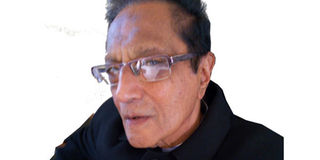The Aga Khan Diamond Jubilee: Special connection for Uganda Ismailis

Dr Jamal was a senior research economist
I looked recently at our newspapers to find if any attempt was made in the coverage of the Aga Khan’s Diamond Jubilee (60 years of ascending the throne of the Ismaili Imamat on July 11) to show the importance of the landmark for Uganda Ismailis and even Uganda. What we got was the standard material about what the Aga Khan Development Network does in Uganda. Lots, but without that special connection, the story is like “Hamlet without the Prince”.
Allow me to fill in two connecting - and connected - events which make the observance of the Diamond Jubilee so emotion-packed for Uganda Ismailis everywhere. The first is that one ceremony for the coronation of the Aga Khan had perforce to be performed on the grounds of the Ismaili jamatkhana (prayer house) in Kampala because of a last-minute objection by the Lukiiko against a non-Baganda king being coronated on public Buganda land. The original site chosen was Nakivubo stadium.
Just in 10 days or so, volunteers came together from all villages to build the stage. Exams were very near, but we spent as much time as we could on the grounds of the jamatkhana and during the days of the ceremony itself. Because of the small size of the compound, the emotions could be seen on every face and on every mouth, the story was of the “miracle” that was actually happening. A band had come from Pakistan who wore Scottish kilts and played bagpipes.
The old Aga Khan’s Begum joined in the celebrations at night.
Fifteen years later (February 1972), the same jamatkhana was the scene of the Imam’s visit to his jamat and within just another six months, of the Asian expulsion. I was in Uganda that year collecting data for my dissertation at Stanford. The special Aga Khan angle in the expulsion starts with the fact that a majority of Ismailis had taken out Uganda citizenship on the guidance of the Imam himself and were rendered stateless in the verification exercise. Things were frantic as people went from one embassy to another to find a host country. Then the rumour that the Canadians were coming came true – and that then brings us the very special Aga Khan angle in the story.
The Canadian mission set up in the Aga Khan’s IPS (Industrial Promotion Services) building, no less. In writing a book I came across the diary of the chief of the Canadian mission that had come to process us – Roger St Vincent. I took lots of extracts out of it to make the story come alive. The Aga Khan’s role is evident there and it also comes through in people’s own stories. My parents and elder sister and brother-in-law passed the Canadian interviews. Younger sister and husband wanted to stay on their accepted Uganda citizenship, but were scared off when gunmen appeared at their gate. They too secured Canadian visas.
There is more of the Aga Khan angle! Unknown to most people, at the last week of the expulsion deadline, some 6,000 Uganda Asians were practically stateless as they had given up on their plans to stay on in Uganda on their confirmed citizenship, or were handicapped or of mixed race and practically abandoned by their families. Amin was ratcheting up the rhetoric: So you want to stay on in Uganda? Feel welcome to go dig the shambas. The UNHCR advised people to simply throw away their Uganda passports and report at their staging posts.
The Aga Khan’s uncle Prince Sadruddin was the head of the HCR at that time. Within just a week or so, the HCR took away the 6,000 or so stateless Uganda Asians and sheltered them in centres in five European countries. At this time, UNHCR were dealing with 500,000 displaced persons from Southern Sudan and yet they devoted so much attention to us! The Aga Khan and UNHCR are accorded “hero” status in my book, along with Canadian prime minister Pierre Elliot Trudeau.
There is a sequel even less often brought out: The 7,000 or so Uganda Asians (of all sects) that Canada took were the first batch of non-white refugees they were accepting, against sporadic opposition from the right-wingers. Within just six months or so of arriving in Canada, the refugees had found their own feet in business and professions, so much so that the next Canadian prime minister Chretien, was quoted as ruing why more of the Uganda Asians had not come to settle in his constituency.
But there is more: Our successful resettlement in Canada encouraged Canada to accept thousands of refugees from Vietnam and that then contributed to Canada incorporating multiculturism in its law in 1987.
And that encouraged His Highness the Aga Khan in establishing the Global Centre for Pluralism in Ottawa, rather than what at that time was seen as its “natural” setting – London. Quite evidently, the Global Centre is a celebration of what Canada is, and the Uganda Asian resettlement done under no other than the Aga Khan contributed to it!
So much to remember in Uganda at this landmark jubilee of our Imam! Our Uganda jamat now consists of only 250 or so “original” Uganda Ismailis, swamped by 10 times as many “newcomer” Ismailis from India and Pakistan. I am quite certain as many Uganda Ismailis living in the diaspora countries will come for the jubilee ceremonies to make this a happy reunion.
We can be sure many of the stories above will be remembered. Uganda’s “pluralism” too, under President Museveni’s repossession overture to the departed Asians will be celebrated then. What a win-win!
Dr Jamal was a senior research economist, UN-ILO, 1976-2001. [email protected]




